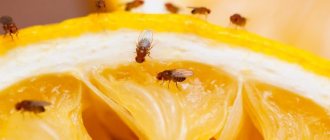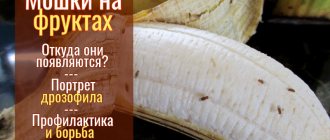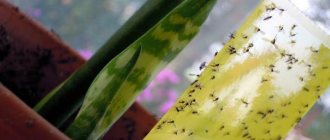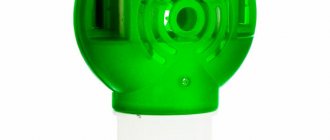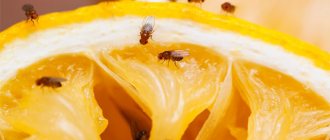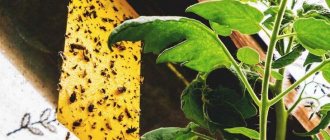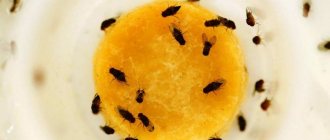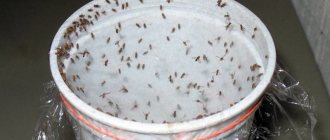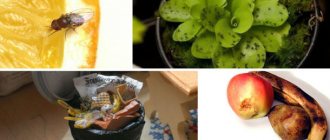As the harvest season begins, many are looking for a way to get rid of fruit gnats. These small annoying insects do not cause serious harm, but they can spoil food and nerves. There are many ways to combat these pests: poisonous sprays, traps, a rich arsenal of folk remedies. Let's find out how insects get into the house, what to do to prevent their appearance, and how to remove fruit flies from an apartment or private house.
Where do insects come from in the kitchen?
The fruit midge is a small black or brown insect that, like the house moss, belongs to the order Diptera. These insects feed on plant fruits that have begun to deteriorate and rotting plant matter. On warm summer days, they can appear in the kitchen, starting in a bag of fruit or in a trash can. To fight these insects, you need to understand where they come from and how they get into the house.
Even the cleanest home is not immune from infection with fruit flies. Flies appear from eggs laid by adult insects on fruits while they are still ripening. Then the fruits are picked, brought into the house and stored, forgetting to wash. There is now enough heat for the rotting process to begin. The eggs will then hatch into larvae to feed on the rotting mass and develop into adult flies.
There are other ways of infection:
- Invasion of flies from the yard through a window or ventilation ducts. This path is especially relevant for private houses. If there are apple trees or other fruit trees in the yard, it is necessary to promptly remove rotting fruits from under them. Otherwise, fruit flies will appear on the rotting remains and fly into the home in search of food.
- Insects enter the house along with contaminated soil. Flower pots are often where midges appear. Soil that has been fertilized with humus is especially dangerous.
To avoid the proliferation of fruit flies in flower pots, do not use “spent” tea leaves to feed plants. Rotting tea leaves are an attractive environment for insects to appear.
Knowing the ways in which midges enter your home, it is easier to organize effective prevention of infection.
What are midges like in a house or apartment?
Fruit midges are very small dipterous insects, the length of which does not exceed 2-3 mm. In total, there are more than 1000 species; in our country alone there are 40 of them. We will not delve into the specific features of the species, since they all annoy us in the same way. Drosophila are extremely prolific insects. The female lays up to 120 eggs in one clutch. Thus, over the entire life cycle, it can produce from 600 to 2000 individuals of its species. Due to active reproduction and the rapid transformation of eggs into adults, it is not so easy to fight fruit flies.
Eggs laid on the surface of food can remain dormant until favorable conditions for development are created. For example, as soon as a fruit infected with Drosophila eggs begins to rot, the eggs will quickly turn into larvae, pupate and adults will appear. The female Drosophila is ready to reproduce already 8 hours after birth.
The flying apparatus of fruit flies does not allow them to travel significant distances. A midge can cover no more than 180 meters per day. Therefore, they simply cannot fly from somewhere; the reason for their appearance must be looked for nearby. In general, fruit flies are practically never found in the wild; they settle mainly near humans. And no wonder, there is always something to enjoy here.
Drosophila love moist and shaded places and are especially active at sunrise and sunset. In hot weather they prefer to stay in shelter.
Surprisingly, there are cases where fruit flies are specially bred. This applies to those who are involved in breeding and keeping ants. Drosophila are an excellent food for them. But we won’t have an anthill in the house, so we’ll have to get rid of the midges in the apartment and find out the reason for the appearance..
Where do midges come from in the kitchen?
There are several reasons why midges appear:
- rotting of plant matter - the fermentation process and the unpleasant odor that accompanies it, attracts insects, and midges lay eggs on the remains of food;
- wet dirty rags and dishwashing sponges, a dirty sink create a good environment for the rapid reproduction of insects;
- a dirty trash can from which garbage is not thrown out in a timely manner;
- flower pots, if tea leaves are added to them, which begins to rot when watered;
- midges can enter the apartment through ventilation holes and pipes.
Reproduction of midges
At a room temperature of 25 degrees, the life cycle of these insects will be 10 days. If the constant temperature is within 18 degrees, then life expectancy increases to 1 month.
The reproduction of food midges occurs according to the following scenario:
How to clean the oven from grease and carbon deposits: tips and more effective methodsWhat to do if your kitchen sink is clogged: how to clear the clog yourself
Installing a siphon under a kitchen sink with your own hands: assembly and connection diagram
- The female lays about 400 eggs in the water, and within 24 hours they hatch into larvae. Over the course of 5 days, the larvae grow, and at 24 and 48 hours after birth they begin the process of molting, after which they crawl to the surface of the water and, when dry, become covered with a shell. After five days, the larvae turn into adults - adults.
Throughout their lives, females are fertilized only once, and after mating they will lay eggs constantly. The sperm will remain inside the female all this time.
How dangerous are midges for humans?
Countless numbers of these tiny creatures move around the home at high speed. They are found either next to the trash can or next to indoor plants. If you leave a few grapes on the table, they will immediately appear above them. Many owners practice storing fruits and berries on the table, in fruit vases, which naturally attracts fruit flies, as the fruit quickly begins to deteriorate. At the same time, it is not difficult to imagine what they could leave on food if their route of movement intersected with a trash can, bathroom or toilet. The result of their vigorous vital activity may be contamination of fruits and other food products with various fungal or infectious diseases.
There is only one conclusion: it is necessary to take all measures to ensure that these little parasites no longer exist in the apartment. If you don’t fight them, they will multiply to such an extent that it will be very difficult to fight them. Despite this, the matter will have to be brought to its logical conclusion. Who would like to see swarms of insects moving around the kitchen or throughout the apartment? They won’t even let you eat in peace!
Preventing the appearance of fruit flies
To prevent a whole swarm of annoying midges from appearing in your apartment, you need to make it as unattractive as possible for insects as a breeding place. The following measures will help with this:
- Destruction of food supply. The trash can must be tightly closed with a lid and removed promptly. Any fruit that has begun to spoil should be thrown away without any pity - or the spoiled parts should be removed. Also, preventive measures include timely removal of food from the table, proper storage of flour and cereals (closed containers, timely disposal of spoiled foods, etc.).
- Elimination of water sources. Like other pests, fruit flies need a source of moisture. A leaking faucet, a dripping pipe joint, or even a constantly damp cleaning rag will do the trick. Remove all sources of liquid and your home will become much less attractive to midges.
- Maintaining good hygiene. Before storing fruits and berries brought into the house, they must be washed to remove insect eggs from them. Then the fruits are dried and placed in plastic bags. In addition, important preventive measures are wet cleaning, garbage disposal, and timely washing of dishes.
- Blocking access from the street. All opening windows are covered with mosquito nets. Mesh screens are also placed on ventilation vents.
We recommend: Review of anti-rust products in the bathroom: something that will help you clean off even old and stubborn yellow stains in 3 minutes
Following these rules will help protect your home from fruit flies entering your home. If an infestation is discovered, it is necessary to take urgent measures: find a place where flies are hatching (usually a can of cereal, a bag of rotten fruit or a flower pot) and carefully dispose of spoiled food along with the flies.
Reasons for appearing in a person’s home
Drosophila are found very often in an apartment or residential building. Popular places of their settlement:
- flower pots with waterlogged soil (overwatering causes the roots and stems of houseplants to rot);
- rotten vegetables and fruits that were not disposed of in a timely manner;
- supplies in the pantry - fruit flies infest cereals and nuts;
- A trash can that is not emptied every day is rarely washed.
READ ALSO: PRINTING LARGE VOLUME OF DOCUMENTS
Often flies are found in boxes of onions, zucchini or pumpkins stored in the closet, bags of potatoes or beets. It is enough to rot one fruit in a bag for fruit flies to choose this source of food and reproduction.
One of the names - wine fly - was given to Drosophila for its special love for wine smells and fermented food products. Carelessly forgotten and sour jam or compote in an open jar will certainly become a breeding ground for insects. For this reason, it is unacceptable to store empty, unwashed alcohol bottles at home.
Why are fruit flies dangerous?
Attitudes towards fruit flies range from complete disdain to unjustified fear. They are practically safe for humans: they do not bite and do not cause allergies. But the appearance of these insects in the house has several harmful consequences:
- Flies carry the remains of rotten fruit along with bacteria on their legs. Once in food, these bacteria multiply quickly, which leads to food spoilage. Rotten products accumulated in spoiled food can cause food poisoning.
- An annoying midge, flickering in front of the face, landing on the skin, crawling into the eyes and nose, can quickly drive even the most patient person to white heat. Since fruit flies do not feed on blood, humans are not particularly attracted to these insects. But with a strong infestation, the intrusiveness of fruit flies already turns into a problem.
The fruit fly is a popular subject for study in genetics. Thanks to her, many fundamental laws of nature were discovered. But outside the scientific laboratory, this insect does more harm than good.
Despite the relative harmlessness of Drosophila, you should not hesitate to start the fight. The more time passes from the moment the infestation is discovered, the greater the hordes of flies you will have to fight.
Preventive measures
Following simple rules will help protect your kitchen from the appearance of fruit flies:
- thoroughly wash and dry or wipe dry purchased or collected vegetables and fruits;
- Store fruits, berries and vegetables in the refrigerator;
- Immediately discard rotting fruits;
- immediately throw scraps, scraps, and leftover food into the trash;
- Take out the trash every day and cover the trash can with a lid;
- wash dishes immediately after preparing or eating food;
- keep the kitchen clean, regularly wash the stove, sink, wipe the table and work surfaces;
- change dish sponges frequently;
- cap bottles of alcohol;
- Wash pets' bowls daily and prevent food from becoming dry.
Also, to protect against fruit flies, you need to regularly ventilate the room.
The best household chemicals to combat midges
The chemical industry produces many varieties of insecticides and insect repellents. Some of them can also be used to combat fruit flies.
Here are some of the most effective drugs:
- Liquid for fumigator "Kombat". The reservoir with liquid is screwed to the fumigator, then the device is connected to the power supply. The fumigator releases vapors that have an insecticidal effect. In addition to midges, the drug will get rid of mosquitoes and flies. The product acts quickly (the effect is noticeable within an hour) and is affordable. A bottle of liquid costs about 300 rubles.
- Raptor trap with sticky inside. A bait solution is supplied with the trap. It is enough to pour a small amount of solution into the trap and place it in a place where insects accumulate. One trap is enough to effectively protect a room of 10 square meters. m for a month. At the same time, the outside of the trap remains clean and does not spoil the interior of the kitchen. The price of the set is about 150 rubles.
- Aerosol "Dichlorvos". A powerful, effective insecticide containing cypermethrin and tetramethrin. In most cases, a single treatment is enough to get rid of fruit flies. However, the product is not safe for health - after spraying and exposure, the room must be thoroughly ventilated.
We recommend: Dichlorvos neo odorless: instructions for use
Kitchen cleaning requires special care to ensure that the insecticide does not get into drinking water or food. Before spraying, place all products in tightly closed containers and hide them in a closet. Flowers and pets are also removed from the kitchen, and children and elderly family members are prohibited from entering the premises during treatment.
How to prevent kitchen bugs from returning
To prevent fruit flies from appearing again, you must follow these simple rules:
- Take out the trash promptly and do not allow the waste bin to become dirty.
- Do not leave food or uneaten food on the table. Be sure to make room in the refrigerator for perishable foods and in plastic containers for cereals.
- Wash dishes on time.
- Wet clean the kitchen every week. Try to wipe the stove, sink and counters dry.
- Water your house plants in moderation, immediately remove fallen leaves, and sprinkle the soil with sand or decorate with decorative stones. This will prevent the appearance of midges.
Folk remedies: cheap and safe
The use of industrial insecticides is justified as “heavy artillery” - as a last resort in case of severe infestation. In other cases, it is better to use safer folk remedies:
- Smelling foods have a good effect in the fight against fruit flies: garlic, cloves, orange peel, vinegar.
- Indoor plants that emit strong odors, such as geraniums, will help.
- Another helper is tape with an adhesive surface.
- A homemade poisonous composition gives a good effect: half a glass of milk, 40 g of sugar, 40 g of black pepper. Saucers with the solution are placed in places where flies accumulate.
We recommend: How to soak salted herring quickly: in water, milk, tea
Often these products are sufficient to combat fruit flies.
Tips and tricks
- Take 100 grams of milk and 2 teaspoons of sugar, 1 tsp. pepper Soak toilet paper in this mixture and place it on a saucer.
- Place a piece of rye bread in a plate and pour the following solution over it: 3 tbsp. spoons of milk, 4 tsp. baking soda and ½ tsp. formaldehyde.
- Place a napkin soaked in 10 g of honey and 1 g of saccharin on the windowsill.
- Stick a match into the flower pot, sulfur into the soil, the fruit flies will die.
- An ultrasonic trap and cleaning the room with ultraviolet light, with a frequency of use once every 7 days, help a lot.
- Leave the kombucha overnight.
- Caught flies must be placed in the freezer for a while; they die instantly.
- In order not to throw away the glass jar with flies, you can place them in the microwave and turn them on for one minute (power 600). The flies die, and wash the dishes thoroughly with detergent.
- Mix apple cider vinegar with water and detergent and pour into a jar. Leave for several hours. Vinegar strongly attracts insects, and detergent will not allow them to get out. Renew the solution periodically (once every 7 days).
- Place the raptor plate in a sunny place. When heated, a pungent odor will be released, which is poisonous to fruit flies.
- Put the remaining horseradish in the bag, the midges will all disappear.
There are many and quite simple methods of dealing with uninvited guests. Choose what you like.
How to make a trap with your own hands?
You can make an effective fruit gnat trap yourself. Place a piece of apple, apricot or other sweet bait at the bottom of the glass jar. A sheet of paper folded into a funnel is inserted into the neck; a hole with a diameter of 3 mm should remain in its lower part). The flies will begin to make their way into the jar towards the bait, but will no longer be able to get out.
Getting rid of a brood of fruit flies is quite simple. The main thing is to notice the infection in time and take action quickly. Then the insects can be defeated using homemade traps or folk remedies. And, of course, do not forget about prevention. Throw away rotten fruits in a timely manner, do not forget about cleaning - and fruit flies will not become a problem for your home!
How to get rid of eggs
Since adult insects lay eggs on ripe fruits, getting rid of them is quite simple:
- Wash the brought fruits or vegetables thoroughly under the tap.
- Next, pour boiling water over them.
- All vegetables and fruits must be kept in the refrigerator, since the reproduction process does not occur here.
It is a little more difficult to get rid of midge eggs from indoor plants:
- The flower from the pot should be replanted.
- The leaves should be wiped with soapy water or alcohol.
- Next, the soil changes. It is good to use a purchased substrate. It is specially treated against all kinds of parasites.
- When using soil from planting, you need to do your own preventative measures.
- Place the soil on a tray and put it in the oven for a couple of hours.
- All parasites in the soil will die during this period.
- Plants are treated with a floral remedy against midges.
- Rotten roots are cut off.
- Next, prepare a warm solution with potassium permanganate, into which the plant is lowered for a few minutes. A weak concentration is used.
- Then plant the flower in a pot. All fruit fly eggs will be destroyed.
- When further caring for the plant, do not forget to loosen the soil and monitor excess moisture.
Types of Drosophila midges
Honey flies are a harmless insect, although annoying. Scientists count several thousand species, although only 1,500 of them are described in detail, 40 live in European countries.
Drosophila melanogaster (other names: fruit fly, honey fly, fruit fly, small fly, wood sorrel) is a small, approximately 3 mm in length, insect belonging to the family Drosophiliadae, order Diptera. External characteristics: red eyes and brown-yellow coloration with black rings on the abdomen. The female's body is approximately 2.5 mm, while the male is smaller and has a darker rear. It is these midges that usually appear in houses and apartments.
By the way, the melanogaster subspecies is highly valued by geneticists because it is ideal for experiments.
And especially for aquarists, a wingless subtype has been bred, which is used to feed fish and reptiles.
Drosophila funebris (called the large or vinegar fly) is larger than melanogaster by an average of 1 mm. It lives mainly near ponds, barrels or other vessels with fermenting/rotting liquids, and less often found in fruits.
About the insect
Drosophila, small flies, breed in fruits. In everyday life they are called fruit or wine. These two-winged insects contributed to the development of biology by serving as a model specimen. In addition, an individual Drosophila visited space on a “scientific mission.”
The life cycle of the insect reaches up to twenty days, depending on the temperature, but rapid reproduction with the ability to lay up to four hundred eggs during this time creates the preconditions for a rapid increase in numbers under favorable conditions. They are even bred specifically for feeding terrarium inhabitants and aquarium fish. Rotten fruit is an ideal place for fruit flies.
